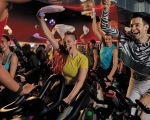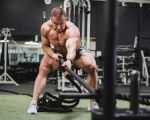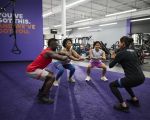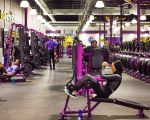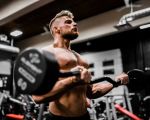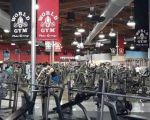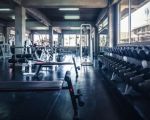
Finding the Best Gym for Flexibility Training: A Personal Journey to Improve My Flexibility
As someone who has struggled with flexibility for most of my life, I know the importance of finding the right environment to help me stretch, grow, and ultimately improve my range of motion. Whether you're aiming for better mobility, preparing for a specific sport, or simply looking to feel more comfortable in your own body, selecting the right gym for flexibility training can make all the difference.
The Challenges of Improving Flexibility
Flexibility training is often one of those fitness goals that gets overlooked. Many people focus on strength, cardio, or endurance, but flexibility is just as crucial for overall well-being. I used to think that I could just do a few stretches here and there and expect my flexibility to improve over time. However, it quickly became clear that this wasn’t enough.
For years, I had tight muscles and a stiff body. Yoga helped a little, but I found that doing the same routine over and over wasn’t enough to truly unlock the flexibility I was seeking. It wasn’t until I joined a gym that offered specialized flexibility programs that I realized how important it is to have a structured, guided approach.
What to Look for in a Gym for Flexibility Training
Choosing the right gym for flexibility training can be overwhelming, especially with so many options available in the USA. Here’s what I found helpful when searching for the best gym for improving flexibility:
- Certified Trainers: I needed trainers who not only understood flexibility but could also tailor their advice to my specific needs. Having a certified instructor who specializes in flexibility or has a background in yoga or physical therapy is essential.
- Variety of Flexibility Classes: I wanted to make sure the gym offered different classes that focused on flexibility, such as yoga, pilates, and stretching-focused strength training. A one-size-fits-all approach doesn’t work for flexibility, and having diverse classes allowed me to experiment with different techniques.
- Proper Equipment: Although bodyweight stretches are great, I found that having access to props like foam rollers, stretching bands, and resistance machines was essential. These tools help facilitate deeper stretches and allow for a more comprehensive flexibility program.
- Personalized Training: It’s crucial that the gym offers personalized sessions, especially if you have specific flexibility goals, like improving your hamstrings or hip mobility. A personal trainer can assess your current flexibility and create a program that works for your needs.
- Location and Environment: For me, it was important to choose a gym that felt welcoming and comfortable. A positive environment made it easier to commit to my flexibility goals. A gym with a relaxing, spacious atmosphere made me look forward to my flexibility sessions instead of feeling stressed or rushed.
My Experience with Flexibility Training at a Gym
After months of searching, I finally found a gym that met all of my flexibility training needs. The first time I walked into the gym, I was a bit skeptical. It seemed like just another typical gym with rows of equipment and weight racks. But as I explored further, I found an entire area dedicated to stretching, yoga, and mobility exercises. There were a few classes on the schedule that focused specifically on flexibility, and I decided to give one a try.
The class was unlike anything I had ever experienced before. The instructor had an incredible depth of knowledge about flexibility techniques. Instead of just leading us through a series of stretches, they took the time to explain the muscle groups we were targeting, the benefits of each stretch, and the science behind improving flexibility. That class completely changed my outlook on flexibility training and helped me realize that true flexibility requires not only consistent effort but also a deep understanding of how the body moves.
Over time, I started attending a combination of yoga, pilates, and dedicated flexibility workshops. Each class focused on different areas, like hamstring flexibility, spinal mobility, and hip opening. The variety kept me engaged, and I saw noticeable improvements in my flexibility. My back pain decreased, I could perform daily tasks with greater ease, and even my athletic performance improved. I felt stronger, more mobile, and, most importantly, more comfortable in my body.
How Flexibility Training Changed My Life
As I continued to train at the gym, I noticed that my flexibility not only improved physically but mentally as well. The focus on breathing, mindfulness, and proper movement made me more in tune with my body. It was a way to disconnect from the stress of daily life and focus on healing and stretching. Flexibility training became more than just a physical pursuit; it became a form of self-care.
Perhaps one of the most impactful moments was when I noticed that I could finally touch my toes without straining. It may sound small, but for me, it represented a massive milestone in my flexibility journey. That feeling of accomplishment motivated me to push even harder. I knew I had found the right gym and the right approach to flexibility training for my body.
Tips for Staying Motivated with Flexibility Training
Even with the right gym and support, staying motivated can be challenging at times. Here are a few tips that helped me stay on track:
- Track Your Progress: I kept a journal of my flexibility improvements, from the distance I could stretch to how my muscles felt after each session. Tracking progress helped me stay motivated and see how far I had come.
- Celebrate Small Wins: Whether it was being able to hold a deep stretch for a few more seconds or feeling less stiffness in my shoulders, I made sure to celebrate every small victory along the way.
- Find a Flexibility Buddy: Partnering with a friend or joining a group training session kept me accountable. Having someone to share the journey with made the process more enjoyable.
- Mix Up Your Routine: Doing the same stretches every day can get boring. I regularly changed up my flexibility routine by trying new classes or using different equipment.
In conclusion, finding the best gym for flexibility training has been a game-changer for me. It not only improved my physical flexibility but also helped me gain mental clarity and a greater connection to my body. If you’re on a similar journey, I highly encourage you to explore different gyms, talk to trainers, and find a place that makes you feel supported and motivated to reach your flexibility goals.
Looking for the best gym or services for flexibility training? Visit us at [Fitness] to get the best recommendations tailored to your needs.

